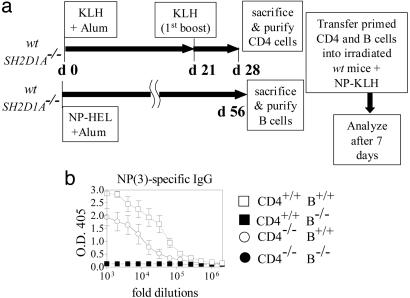Fig. 3.
Reduced hapten-specific antibody responses after cotransfers of primed SH2D1A-/- CD4+ T cells with wt B cells or primed wt CD4+ T cells with SH2D1A-/- B cells into irradiated wt recipient mice. (a) Outline of the experiment. CD4+ T cells were purified from the spleens of SH2D1A-/- BALB/cor wt BALB/c mice that had been immunized with KLH attached to alum on day 0 (d 0) and boosted on day 21. B cells were purified from the spleens of SH2D1A-/- BALB/c or wt BALB/c mice that had been immunized 56 days earlier with NP-hen egg lysozyme (Materials and Methods). The purified CD4+ (5 × 106/recipient) and B cells (10 × 106/recipient) were then cotransferred into irradiated wt BALB/c recipients. At the same time, 100 μg of NP-KLH was injected. Four combinations of CD4 and B cells were used to reconstitute the irradiated recipients: [CD4+/+ B+/+]; [CD4+/+ B-/-]; [CD4-/- B+/+] and [CD4-/-B-/-], in which [-/-] represented SH2D1A-/- and [+/+], wt. Reconstituted animals were killed and analyzed 7 days after transfer. (b) Hapten-specific antibody responses. High-affinity NP-specific IgG antibody titers in the serum of recipient mice (n = 4) were determined, as described in Materials and Methods (n = number of mice tested per experiment). Results are representative of two independent experiments. Results of ELISAs are shown as follows: y axis, OD 405 units; x axis, fold dilutions. -/-, cells derived from SH2D1A-/- mice; +/+, cells derived from wt mice; open squares, mice reconstituted with CD4+/+ B+/+ cells; filled squares, mice reconstituted with CD4+/+B-/- cells; open circles, mice reconstituted with CD4-/- B+/+ cells; filled circles, mice reconstituted with CD4-/- B-/- cells.

